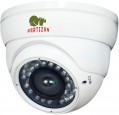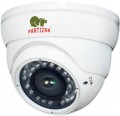Cloud storage
Compatibility of the camera with one or another
cloud storage. This paragraph may indicate the very fact of compatibility or specify the specific service (services) for which the device is designed — usually it is Google Drive or Yandex Drive, and often both at once.
Recall that cloud storage is an information storage system located on remote servers. Data is transmitted to such a system via the Internet, and the owner can also access them via the World Wide Web, regardless of their own location. In addition, modern "clouds" allow you to share selected information with other users. The basic functionality of such services and a certain amount of disk space are usually available for free, but for advanced features and increased storage, payment is required (one-time or regular subscription, depending on the specific service).
Specifically, in this case, compatibility with cloud storage means that the camera is able to directly transfer footage and other information to such storage. This provides two important advantages at once. The first has already been mentioned — the ability to work with videos (view, copy, share, etc.) from almost anywhere in the world where there is access to the Internet. The second point is additional reliability and security: even if the surveillance system's own storage device (recorder, local server, etc.) is damaged or destroyed, a copy of the footage will still remain in the "cloud".
<
...Br> Note that cloud storage support is also found in registrars with network capabilities. However, the purchase of cameras with such functionality is convenient because such cameras do not need additional equipment to work with the "cloud".Illumination range
Operating range of the backlight (see "Design and capabilities") installed in the surveillance camera. This term usually means the maximum distance from the camera to the observed object, at which it is able to provide a relatively high-quality and legible image in the complete absence of other light sources. Of course, the actual backlight range may differ from the claimed one, and these differences are most often in the direction of increase (for example, due to the presence of the same additional light sources). However, if the possibility of shooting with backlight is important for you, you should focus on the claimed range.
Matrix size
The size of the matrix installed in the surveillance camera (diagonally).
In general, larger sensors (with the same resolution and sensor type) are considered more advanced: they get more light, which has a positive effect on image quality (especially in low light). On the other hand, increasing the size affects the cost of the entire device; and in some cases (for example, if the camera is not planned to be used in twilight and darkness), a relatively small sensor may be quite suitable.
As for specific dimensions, the most modest cameras in terms of this indicator have matrices of
1/4 "or less. Models with sensors of
1/3.8" - 1/3" and
1/2.9" - 1/2" are very popular, these values can be called average. And in advanced devices, diagonals and
more than 1/2 "(up to 1/1.7") are found.
Minimum illumination
The lowest degree of illumination of the scene being shot, in which the camera is able to provide normal visibility. Usually, this item specifies the values for the daytime mode of operation (in the night mode, the minimum illumination in many models may be zero at all, because in such cases the IR illumination is turned on, see "Design and capabilities"). And if the camera is capable of shooting in colour, it usually means the lowest illumination necessary to obtain a colour image.
The lower this indicator, the better the camera works in low light, the brighter and more clearly visible image it is able to provide in such conditions. At the same time, note that in low light, night mode is often preferable, and in the presence of the aforementioned IR illumination, it is more likely to focus on the range of its operation (see above).
There are comparative tables that allow you to evaluate the degree of illumination indicated in the characteristics from a practical point of view: for example, an indicator of 0.2 lux corresponds to clear eyes on a full moon.
Aperture
Aperture of the lens installed in the camera.
Aperture characterizes the degree of attenuation of the light flux when passing from the front lens of the lens to the matrix. It is denoted as the ratio of the diameter of the active aperture of the lens to the focal length, while the size of the active aperture is designated as f and is taken as a unit — for example, f / 1.4 or f / 2.0. Moreover, the smaller the number in the designation, the higher the aperture (in our example, the second lens will be darker than the first). And for lenses with a variable focal length (see "Focal"), the actual aperture, usually, changes with a change in focal length; for such models, either the range of aperture values, or its maximum value, can be indicated.
By itself, this parameter characterizes, first of all, how light the image taken through the lens turns out, all other things being equal. High values are important, first of all, when shooting in low light conditions: a fast lens allows you to get a fairly high-quality image without increasing the sensitivity of the matrix, which is fraught with noise and “blurring” of the picture. On the other hand, the actual quality of camera operation (including in dark conditions) also depends on many other factors — the type and size of the matrix, signal processing features, etc. Therefore, aperture in most cases is more of a reference than a practically significant parameter.
Video compression format
The video compression format used by the camera.
Compression is used to reduce the file sizes of captured video; different technologies can be used for this — the so-called codecs, their list is given in this paragraph. From a practical point of view, compatibility with external recording and playback devices primarily depends on the supported codecs. If you plan to use a computer as a recorder / player, you can ignore this list: modern PCs and laptops usually support a very extensive list of formats, and in extreme cases, the missing codecs can be installed separately. But if we are talking about specialized registrars, individual players (like home media centers), etc. — codec compatibility should be clarified further. So, if the advanced modern
H.265 standard is very widely supported nowadays, then the more specific
H.265+, originally created for surveillance systems, is much less common even in specialized equipment.
ONVIF
ONVIF in this case is a set of rules (protocols) for the interaction of different components of a video surveillance system. This set was developed by the organization of the same name (Open Network Video Interface Forum) and is widely used in equipment from different manufacturers. In the case of cameras, this means that an
ONVIF-compliant camera will be able to work properly with any brand of equipment, as long as it also supports this standard.

